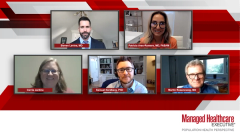
Alternative Treatment Options for TRD
Dr Patricia Ares-Romero and Dr Martin Rosenzweig discuss treatment strategies for TRD, including alternative therapies and explain current barriers within the healthcare system that inhibit access.
Episodes in this series

Steven Levine, MD: You’re painting a picture with a lot of complexity. Within that, there are a lot of patients who, despite all these considerations, have an accurate diagnosis of major depressive disorder and aren’t benefiting from oral antidepressants. Within that world and the consideration of potential prescription of nonoral approaches to TRD [treatment-resistant depression], Dr Ares-Romero, in the face of all that complexity, how do you think about determining an ideal candidate for these therapies?
Patricia Ares-Romero, MD, FASAM: I agree with everything that was said, but a good psychiatric clinical history to initiate is key. We need to make sure we know what we’re treating and then evaluate. What has the patient responded to in the past? What haven’t they? Comorbidities are part of a good clinical history that we need to address. Once you do that and you have the picture of what this patient in front of you is presenting with, then you can really assess. What have they responded to? Why aren’t they responding? And of course ruling out that they haven’t responded because of other reasons, because they have chronic pain or are homeless or they can’t get food for their family.
It’s important to confirm that it’s not those things and that it’s truly that they haven’t responded. They have the TRD diagnosis, they have a major depression diagnosis, severe or moderate to severe. Then you’re able to say, “They haven’t responded to 2 medications. How much more am I going to put this patient through before I make another decision to treat the patient with TRD?” That’s the way I like to think of the problem; engaging the patient and making sure they understand all the risks vs benefits and all the options. We need to have all the options for patients. Those are some of the challenges.
We spoke about challenges to treatment earlier, and those are some of the challenges we sometimes have. Sometimes you go with a provider and they might not have all the tools in their toolbox. They might not know how to use augmentation therapy with lithium, they’ve never done it before. They don’t even know how to treat somebody with lithium, so they can’t offer it to the patient because it’s not in their wheelhouse. Or they don’t believe in ECT [electroconvulsive therapy] or they have assumptions about TMS [transcranial magnetic stimulation]. We have to be able to give the patients all the options without bias and have them understand the treatment and what it consists of and have the patient engage. Patients advocate for themselves. I encourage my patients to always advocate for themselves, not only with me but with their primary health care providers. It’s getting the patient who’s willing to comply who hasn’t responded to traditional treatment. That’s the right patient for other modalities.
Steven Levine, MD: Very good. In that scenario, you’ve taken a careful history, done your investigation, explored medical comorbidities, looked at prior attempts to treatment and reviewed options with your patients. You may have arrived at a decision that it’s appropriate to prescribe a nonoral medication. But as we know, that doesn’t necessarily mean that the next step is that the patient has access.
Transcripts edited for clarity.
Newsletter
Get the latest industry news, event updates, and more from Managed healthcare Executive.



















































